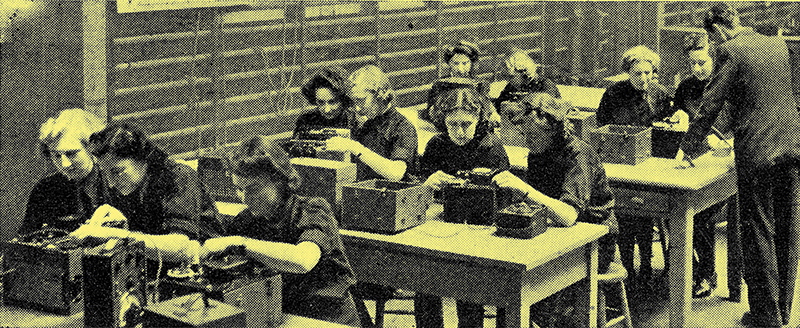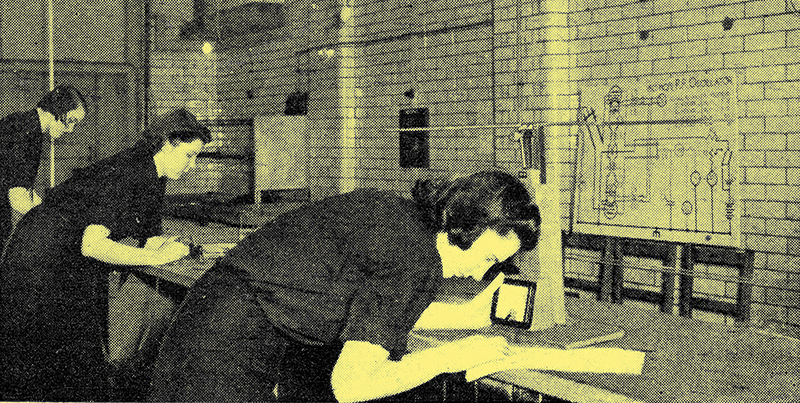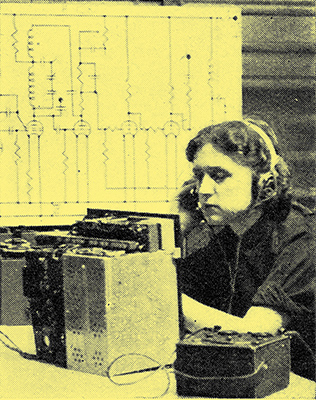|
Three Year Course in Four Months.
Whilst there have been wireless telegraphists and radio operators in the Women's Royal Naval Service for a considerable time, a new sphere of work has opened up for 'Wren' recruits by the introduction of the category of Radio Mechanic.
The function of these girls, who must have had a secondary school or higher education and attained matriculation standard or its equivalent, is the maintenance and repair of apparatus in machines of the Fleet Air Arm.
A Wireless World representative recently visited one of the schools in London where the girls receive their basic training. Some, sixty Wrens were undergoing the sixteen weeks course, which in peacetime would be spread over three years. It is obvious, therefore, that, as the senior instructor in charge pointed out, all the frills have been omitted.

Wren Radio Mechanics receiving instruction on Service apparatus.
The sixteen weeks training is divided into three sections. The first, of five weeks duration, covers magnetism and elementary electricity. The following eight weeks is taken up with the study of the basic principles of wireless, and during the last three weeks the students are taught high-frequency and UHF technique.
Each week of the training period consists of forty-one-working hours in the school plus three hours for physical training. The week's timetable allows fourteen hours for lectures and tutorial study; twenty-two hours for laboratory work and five hours in the mechanical and electrical workshops, where training is concerned mainly with soldering and executing temporary repairs to Service receivers.
Comprehensive Syllabus

Exploring the propagation of ultra-high frequencies with the aid of Lecher wires and sliders. Variations are observed on the large scale on the wall. The half-Wave dipole receiver in the foreground is used for exploring radiation.
The laboratory training is very comprehensive. It must be remembered that these girls, although they have reached matriculation standard or even higher at school, have little or no knowledge of radio. Among twenty or more entrants who were undergoing the first week of training at the school visited a very wide variety of previous occupations was to be found, including those of nurse, shorthand typist, accountant, research student and laboratory assistant. One of the students is a BSc and another had obtained an inter in Physics. Their ages are mainly in the early twenties, although one or two are over thirty. Experience, however, has shown that the best age for absorbing the technical instruction is between 18 and 25.
As the training is planned to give a working knowledge of radio communication in the short time of four months, it will be of interest to consider the syllabus in some detail. The ground is covered very thoroughly. Starting off with the nature and effect of electric current the students progress by easy stages through Ohms, Kirchhoffs and Lenz's laws. They are then introduced to resonance and the effect on frequency of change in L and C. A very thorough series of lectures on alternating current is followed by a course on radio frequency circuits. Valve construction and the functions of the various electrodes lead up to a study of the principles of the CRO (Oscilloscope).
By means of dissected diagrams and demonstration units of the different stages in a receiver the trainees trace signal from the aerial through each stage of the circuit to the output. thoroughly grasped the principles of reception they are given an outline of the transmitter. The final stage concerns the propagation of UHF, the travelling and standing-wave phenomena and the various receiving and transmitting aerials.
The tutorial work is combined with practical laboratory training. An interesting feature is that the Wrens are, as far as possible, given the opportunity of handling actual Service apparatus. The students are not, as is so often the case with special trainees, turned out as 'production line' testers: they are trained in the technique of fault finding and are themselves quite capable of carrying out 'running repairs'.
Perhaps the most exacting part of the Wrens training comes during the last three Weeks, when they are taught the fundamentals of high-frequency and UHF technique. For this part of the course a 150 MHz push-pull oscillator has been erected in a completely screened room. All types of tuned line output circuits, feeders and aerials can be connected to this oscillator. Their properties are examined visually by the students with the aid of exploring sliders connected through Westector rectifiers to a reflecting galvanometer in a prominent position on the wall.
It has been found that the trainees can much more readily grasp the various phenomena in HF and UHF technique by visual means and so the chief instructor employs this method whenever possible.
Following the four month's basic training the girls have two months Service training at a Fleet Air Arm station. Here they are taught the intricacies of installation work and shown the difficulties of servicing apparatus in-situ in planes. Having completed their training. they are posted as Wren Radio Mechanics to a Fleet Air Arm Station.

A feature of the technical training of Wren Radio Mechanics is that the circuit of the Service apparatus under test is easily traceable on the large-scale diagram on the wall.
|